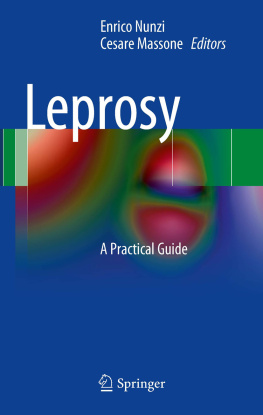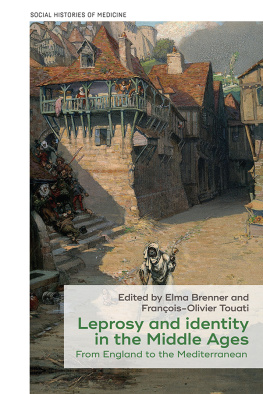Enrico Nunzi and Cesare Massone (eds.) Leprosy 2012 A Practical Guide 10.1007/978-88-470-2376-5_1 Springer-Verlag Italia 2012
1. History and Phylogeography of Leprosy
Abstract
Leprosy results from infection with Mycobacterium leprae , an unculturable pathogen with an exceptionally long generation time that has afflicted human populations for millenia. The history of leprosy has been documented by various civilizations and its global spread deduced from the anthropological record, although scientific proof for the latter is often lacking. Considerable insight into the biology, genetics, and evolution of the leprosy bacillus has been obtained from genomics. M. leprae has undergone extensive reductive evolution, losing DNA from its genome, half of which is now occupied by pseudogenes. Comparative genomics of four different strains from India, Brazil, Thailand, and the USA revealed remarkable conservation of the ~3.27-megabase genome (99.995% identity) yet uncovered 215 polymorphic sites, mainly single-nucleotide polymorphisms (SNP), and a handful of new pseudogenes. Mapping these polymorphisms in a large panel of strains defined 16 SNP subtypes that showed strong geographical associations and helped retrace the evolution of M. leprae and the dissemination of leprosy.
1.1 Background
Leprosy, a chronic, dermatological and neurological disease, results from infection with the unculturable pathogen Mycobacterium leprae []. Many of these cases occur in children, thereby indicating that the chain of transmission remains, albeit weakened; this highlights the need for sensitive and reliable epidemiological methods to detect M. leprae and to monitor its spread both locally and globally. Genome sequencing has proved a particularly powerful means of understanding the biology and genetics of the leprosy bacillus, and comparative genomics has uncovered polymorphisms that can serve as the basis for developing molecular epidemiological tools. Such tools have started to find application and are helping us to understand how M. leprae has evolved.
1.2 History
Leprosy is often described as an ancient disease, but what does that really mean? Certainly, in the context of anatomically modern humans and the civilizations they established in the past 5,00010,000 years the disease may appear ancient, but then one should recall that, from an evolutionary standpoint, where millions of years are the norm, the species Homo sapiens itself actually appeared quite recently. Various lines of evidence, based on haploid markers from mitochondrial DNA and the Y chromosome, together with the archeological, anthropological, and linguistic records, indicate that the cradle of mankind was east Africa. After initially spreading within Africa, humans migrated to the Near East about 60,000 years ago, before spreading to southern Asia and Australasia, Europe, and central Asia, until finally reaching the Americas via the Bering Strait about 14,00020,000 years ago [], the term ancient assumes a different meaning.
There are very old historical reports indicating that leprosy most likely existed in human populations in Egypt [].
It is thought that the Phoenicians from the eastern Mediterranean region were responsible for the dissemination of leprosy around the Mediterranean Basin from 1500 to 300 BCE and that Alexander the Greats soldiers brought leprosy back from India about 325 BCE. In turn, the expansion of the Roman Empire is thought to have resulted in the introduction of leprosy into France, Germany, and the Iberian Peninsula. After the collapse of the Roman Empire, other invaders such as the Barbarians and the Saracens may have disseminated the disease, which reached the British Isles and Scandinavia, from where the Vikings likely served as carriers []. Leprosy was certainly endemic in Europe before the Crusades began in 1095 CE and started to decline gradually from the 13th century onwards, although the reasons for this are unknown. Norway was one of the last European countries to eliminate leprosy, and it was there, in 1873, that Armauer Hansen made his seminal discovery of the leprosy bacillus in biopsies from fishermen in Bergen (editor note: last autochthonous Italian case is reported in 2010). One way of retracing the history of leprosy is to examine the genomes of strains of M. leprae , both ancient and modern, and to identify polymorphisms that have been vertically transmitted for use as molecular epidemiological markers.
1.3 Genomics
Since M. leprae has never been successfully cultured in the laboratory and has a generation time of 14 days, one of the longest known for a bacterium, it has proved extremely challenging to perform microbiological or genetic research with this pathogen. An important breakthrough came when it was found that the nine-banded armadillo Dasypus novemcinctus was naturally susceptible to infection []. Thus, for the first time, it became possible to obtain sufficient bacilli to perform biomedical research, such as vaccine development, with the leprosy bacillus. Once large numbers of bacteria become available, it was a fairly simple matter to extract their DNA in order to carry out whole-genome sequencing. The first M. leprae genome to be completely sequenced was that of the TN strain, originally isolated from a patient in Tamil Nadu, India.
The genome sequence of the TN strain of M. leprae contains 3,268,212 base pairs (bp) and has average G+C content of 57.8% [].
The reductive evolution undergone by M. leprae , in which DNA was deleted from the genome and pseudogenes accumulated, provides a general explanation for its unusually slow growth, although no specific defect could be identified to account for this. Loss of DNA can be explained by homologous recombination events involving dispersed repeats, of which four families have been named []. The presence of some of these repetitive sequences within pseudogenes suggests that they were once capable of undergoing transposition, but as will emerge below, this is no longer the case.
Analysis of the genome sequence has improved our understanding of the physiology, pathogenesis, and genetics of M. leprae and is underpinning the development of better diagnostics and molecular epidemiological tools for monitoring disease transmission.
1.4 Comparative Genomics of M. leprae Strains
To identify polymorphic DNA markers that could be used as the basis of a molecular epidemiological test for leprosy, the genomes of three other strains were sequenced, namely Br4923, from Brazil, Thai-53, from Thailand, and NHDP63, from the USA. Astonishingly, when the four genome sequences were compared, they were found to share 99.995% identity and to display near-perfect collinearity and size. There was no evidence for gene deletions, insertions, or translocations, with all of the dispersed repeats occupying the same positions in all cases []. This four-way comparison revealed only 215 polymorphic sites, including single-nucleotide polymorphisms (SNPs) and small insertion-deletion events (indels). Five new pseudogenes were uncovered, three in strain Thai-53, and one each in strains Br4923 and NHDP63.
In light of the massive gene decay and extensive DNA loss undergone by M. leprae , the exceptional conservation of the genomes of these strains was truly unexpected, even more so when their widely different geographical origins are taken into account. Furthermore, it has been estimated from the number of nonsynonymous substitutions per site occurring in the pseudogenes that a single pseudogenization event occurred in the leprosy bacillus in the last 1020 million years [], and in principle, all cases of leprosy stem from the initial infection with a single clone.








